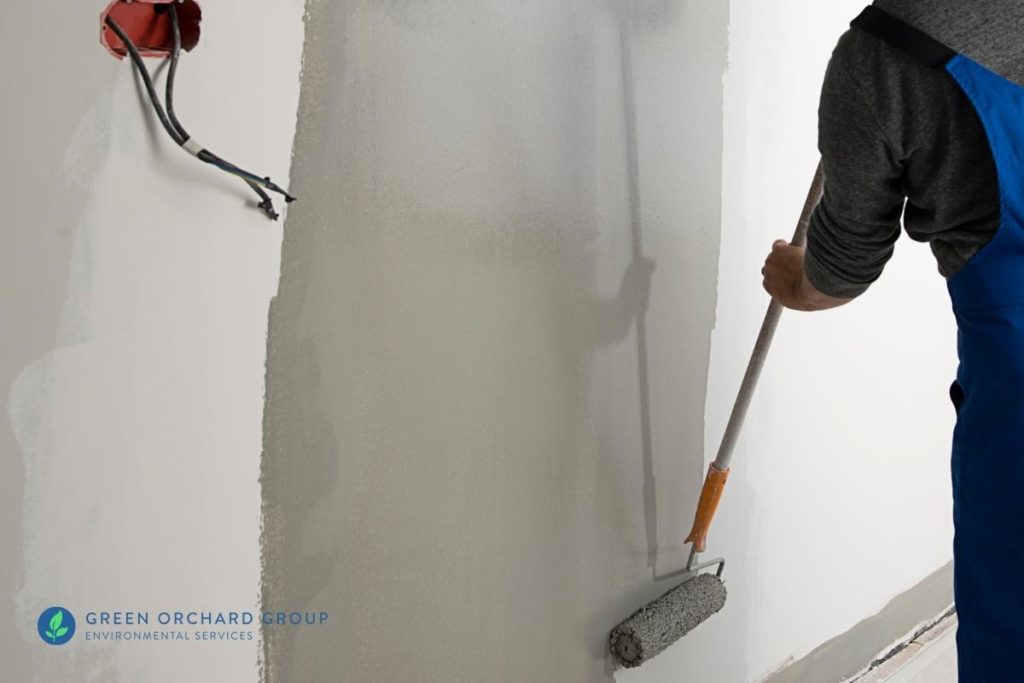
Article Sections
Lead encapsulating paint is a special type of material used to protect homes and families from being exposed to lead paint.
In New York City, many homes and buildings that were built before 1960 still contain lead paint which can release harmful lead-containing dust and chips.
Exposure to lead can cause a variety of health problems, including headaches, nausea, pain, irritability, developmental problems in young children, and risks during pregnancy.
Using lead encapsulating paint to seal and cover high-risk surfaces is one way to prevent accidental exposure to lead.
What is Encapsulation?
Encapsulation is a method of abating lead-based paint hazards in older homes and buildings. The process involves applying a special liquid coating over surfaces with lead paint. This coating can be referred to as an “encapsulant” or “lead encapsulating paint.”
As it dries, the encapsulant bonds to the surface and forms a physical barrier preventing lead dust or paint chips from escaping. As a result, deteriorating lead paint that has been safely encapsulated no longer poses a danger to children and adults.
The main advantage of encapsulation is that it’s often less costly and time-consuming compared to other lead abatement methods, and it’s safer for workers to complete because the process doesn’t typically generate large amounts of lead dust.
However, this method is not suitable for friction surfaces (which are normally subject to repeated friction or impact) or surfaces with significant damage or deterioration (e.g. severe cracking or peeling paint).
What is Lead Encapsulating Paint?
Regular store-bought paint is NOT the same as lead encapsulating paint.
Encapsulants are specially formulated to seal underlying surfaces and prevent the release of lead dust and paint chips. Generally thicker and more durable than conventional paints, lead encapsulating paints must be able to withstand both mechanical stress and exposure to water, temperature, and other environmental factors.
When looking for lead encapsulating paint, check the product label for the terms: “lead encapsulant,” “lead encapsulating paint,” “lead encapsulating coating,” “lead encapsulating compound,” or “lead paint sealant.”
There are three main types of encapsulants, according to the New York State Department of Health:
- Polymer-based
- Epoxy or polyurethane
- Cement-like materials
These cover a range of products with different material types and properties. Some are applied with brushes, rollers, or sprays, while others are applied with trowels. Some may be reinforced with materials like cloth, mats, or fibers for additional stability.
Lead encapsulating paint products on Amazon:
- INSL-X Lead Block
- Fiberlock LBC III
- ECOBOND LeadDefender PRO
- Lead Seal ‘n Stop PRO
- LeadClear
- Dumond Lead Stop

All encapsulants are tested to ensure that they meet the following minimum performance requirements:
- Must be able to be applied safely and not contain toxic substances
- Adhere to existing paint films but not degrade them
- Remain stable and intact for an extended period of time
- Comply with fire, health, and environmental regulations
What to Know Before Using Lead Encapsulating Paint
If you’re planning to use encapsulation to prevent exposure to existing lead hazards, it’s important to note that this method will require periodic maintenance, inspection, and repair, if necessary — especially if you’re applying for a Lead Safe exemption from the HPD.
Also, be aware that different encapsulants should be used in different situations. Before choosing the type of lead encapsulating paint to use, it’s important to take into several important factors:
- Type of base substrate (wood, plaster, steel, cement, etc.)
- Component type and use conditions (e.g. impact, abrasion, rubbing)
- Compatibility with the type of lead-based paint being encapsulated
- Environmental conditions (e.g. moisture and temperature)
- Worker safety regulations
The encapsulant must also be used with the appropriate surface preparation and application procedures in order to be effective. Sometimes field patch tests may be necessary to determine if the encapsulant is right for a specific surface.
How to Use Lead Encapsulating Paint to Abate Lead Hazards
- Choose the appropriate type of encapsulant based on the durability, cost, type of surface, type of lead-based paint, and other factors mentioned above.
- If needed, conduct field patch tests to evaluate the compatibility and adhesiveness of the encapsulant on a small area (usually 6 x 6 inches) before starting work.
- Repair cracks and other types of damage to the surface or building component being abated.
- Prepare surfaces by removing dirt, grease, loose or chalking paint, mold, and other surface contaminants.
- Make sure the work area is well-ventilated, and monitor temperature and humidity levels.
- Follow the manufacturer’s guidelines for specific instructions during when applying the encapsulant.
- Make sure that the coating thickness meets the manufacturer’s specifications.
- Clean the work area with wet mops and/or HEPA vacuums. If you’re a landlord, Local Law 1 may require you to hire a certified professional to conduct clearance dust wipes.
EPA-Certified Lead Abatement in NYC
Have questions about encapsulants or other ways to abate lead-based paint hazards?
Green Orchard Group is an EPA-certified lead inspection & abatement firm in New York City. We have over 25 years of experience helping tenants and landlords with concerns about lead-based paint. Contact us by using the button below or calling (212) 219-8261.
